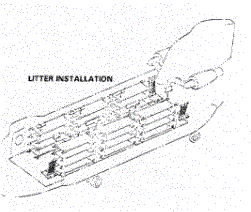CH-47 (Chinook)* |
| The CH-47 Chinook Helicopter has a capacity of
24 litter patients, or 31 ambulatory patients, or a combination of litter
and ambulatory patients.
Because of its' large size and rotor blade diameters, it is most suited to larger landing zones. It should not be brought into an LZ smaller than 40 meters in diameter. The web seats for ambulatory patients are located along the periphery of the cabin. When configured for litter patients, some or all of the seats can be replaced with poles and straps for banks of litters, 4 high. The various mixed configurations are listed here:
Litter patients requiring in-flight medical care should be positioned so they can receive this care. Litter patients are loaded through the lowered rear door and ramp. Litter racks are loaded from top to bottom and from the front of the helicopter to the back. If a mixture of litter and ambulatory patients are loaded, the litter patients should be loaded toward the rear of the helicopter, and ambulatory patients toward the front. If circumstances do not allow for configuring the CH-46 Chinook for litter patients, the web seats can fold up against the wall (with straps) and litters can be placed on the floor of the helicopter. In this improvised situation, do the best you can to secure the litters to the floor, to avoid movement during maneuvering or in the event of turbulence. Unless a medical team has been dispatched to accompany the CH-46 Chinook, there will be no medical attendants and no medical supplies aboard, other than the first aid kits for the aircrewmembers. |
 CH-47
|
||||||||||||||||||
*From Operational Medicine 2001, Health Care in Military Settings, NAVMED P-5139, May 1, 2001, Bureau of Medicine and Surgery, Department of the Navy, 2300 E Street NW, Washington, D.C., 20372-5300
Contents · Introduction · Learning Objectives · Textbook · Lectures · Procedures · Final Exam · Library · Laboratory · Pharmacy · Imaging · Forms · Videos · Search · About the Author · Contact Us
Military Obstetrics & Gynecology
© 2005
Medical Education Division,
Brookside Associates, Ltd.
All rights reserved

